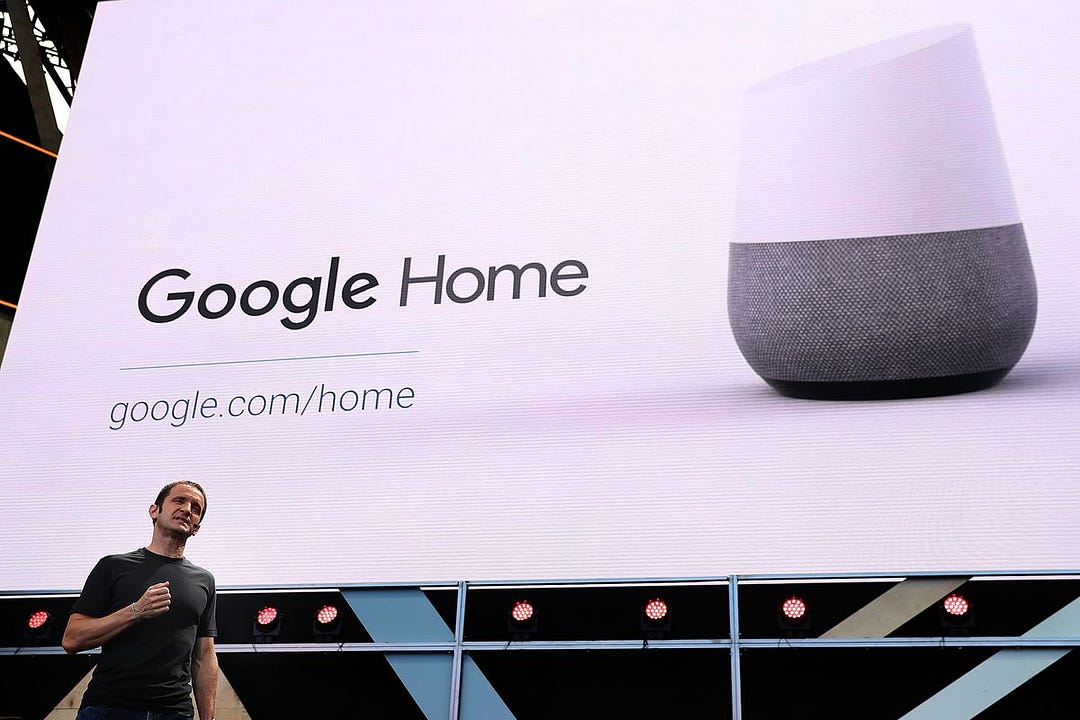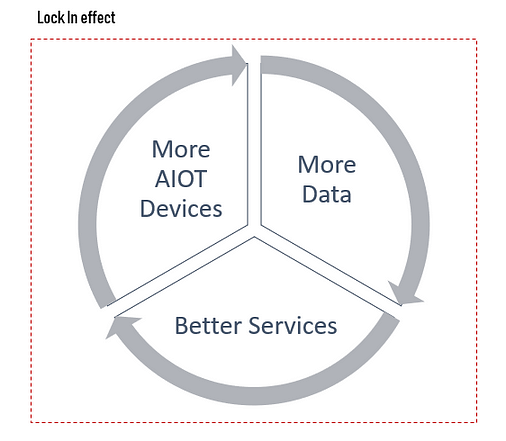
As a member of a research team inside a large tech firm, I wanted to write this article to help others understand why the combination of AI and IoT has a very important strategic meaning for brands. Indeed, you might have heard about AIoT which is the combination of IoT and AI into one physical device. Perhaps the most obvious example of AIoT in use is in retail products.
However, you might not be familiar with the business reasons pushing brands to always invest in this strategic segment. Indeed, there is a war for the space between ecosystems in which companies struggle to keep users on their territory.
Building an ecosystem
Our obsession is to build the perfect product ecosystem. As such, we envision a future where the development of smart homes can be compared to the proliferation of the automobile. The goal is to spread the convenience and comfort that comes with the full-fledged embrace of smart home technology, and make it affordable for everyone.
A single Provider… for all digital needs
We are currently engaged in a race to create this complete ecosystem. The idea is to cover all possible entry points — from devices to platforms to the very internet that they all run on.
The ultimate goal would be to make consumers so used to an ecosystem that it appears essential to their existence, that getting out of it feels like hard work. It is key to build the apparent relevancy of such device in order to increase the willingness to pay.
This will to build a product ecosystem can be seen in your own retail experience. Indeed, brands are no longer focused on where you buy the product, so much as on creating the great products. The objective is to make stores perform from a product ecosystem point of view.
The battle is about making the customer so dependent on whichever ecosystem you self select into, that getting out of it will not seem like an option.
The incremental effort to get the customer out of an ecosystem is huge.
The more devices you own, the easier it becomes to upsell another device that you might not need but yet you think you do. These ecosystems are how companies make money — retention is the key metric, upgrades are due every two years ensuring repeats as the vicious cycle continues.
Some advantages of building a product ecosystem:
- Build bundle packages for consumers to buy at once.
- The more integrated into the ecosystems consumers become, the higher the opportunity cost for them to switch and the better the experience with products working in tandem with each other.
- Customers that own the focus product are more likely to go directly to the site to buy accessories in the ecosystem (bypassing 3rd party e-commerce marketplaces).
From Mobile to Smarthomes devices
Most tech firms seem to follow a path that starts with mobile phones and leads to smart homes. For example, the genesis of Xiaomi’s AIoT revolution is to transform homes into intelligent spaces with devices that can be personalized and customized to the individual’s preferences while offering an unparalleled level of convenience and comfort.
One key advantage to moving into the smart home market is that brands can take advantage of existing smartphone and mobile services customers by offering them additional opportunities to move deeper into an ecosystem they’re already using, while also leveraging data they already have to provide consumers with a better experience than a competitor might.

Google CEO Sundar Pichai said in October 2017 that Google believes the tech world is shifting from a “mobile-first to AI-first” focus. Based on this, it is obvious to see why Google Home matters: It’s the first step in Google’s transition to life as an AI company.
We’re moving into an AI-driven world and AIoT devices are the cornerstone of this future.
The goal of AIoT products ecosystem
As people consume more and more content, each moment of attention creates data that businesses can use. So far, the only problem is that data is typically siloed and scattered across numerous departments and companies. This is what we call the “consumer attention ecosystem.”
However, imagine being able to connect these data points across this ecosystem. With the help of smart devices equipped with AI, a company could have a far more comprehensive knowledge of its customers. Brands want to apply this knowledge to provide a personalized experience for each consumer across disparate moments and channels.
AI acts as data gathering, analysis, and decision-making system to act automatically in some instances, and work under the hood of an interface operated by humans via mobile devices to obtain critical instructions. AI can be applied to data from any of these home automation devices or systems to anticipate and predict user behavior, provide maintenance data, etc.

Without AI, the data that circulates in the IoT would fail to reach its full potential and, without the IoT, AI systems would be without rich data. Out of the data, brands will reinforce the lock-in effect through personalized services.
In my opinion, purchasing decisions consumers make today will lock them into entire ecosystems for years.
The race is very important because the millions of homes where voice control has gained a foothold for smart home adoption will be fertile ground for the wider adoption of a growing range of additional smart home devices, control systems, integrated applications, and vendors. Moreover, If companies do not get the market share as soon as possible, it will be harder for them to get it when the users have adopted other systems already.
Brands that have managed to secure a consequent customer base will soon pivot to deliver new offerings that can be integrated into existing smart homes thanks to AI.
This use of data to drive additional revenue can be seen with Amazon. Indeed, by Echo, Alexa, and initiatives such as Dash. Amazon managed to architect dynamic avenues into the devices that will surround and interact with us every day. Devices able to influence our spending habits and that will automate our household purchases. Purchases that will go directly through the marketplace of Amazon.
We predict that people will be highly reluctant to the idea of switching from one system to another one since that would cause starting over on the learning process. Furthermore, if companies cannot take advantage of the smart home part, they will lose the market share in the other parts of the technology device market.

AIOT Partnerships
The rise of AIOT will also give birth to new partnerships. Indeed, it appears that a strong AIOT ecosystem must rely on collaboration with other firms in a designed ecosystem spanning multiple sectors.
When companies ask us what they should do, we help them answer the following questions:
- Can you help other firms create value?
- What role should your company play in the ecosystem?
- What should the terms be?
ex: who can access the ecosystem, and how exclusively attached your partners must be.
- How many ecosystems should you manage?
I believe The AIoT ecosystem will be more like a community of vendors and enterprises linked together through data and monetary incentives.
Ecosystems bring together vendors and enterprises to monetize IoT products.
Large firms have understood this and although Amazon wants to be everywhere, it has recognized it cannot win the battle for the smart home alone. By investing in the open-source Alexa, the company is converting potential competitors into valuable partners. Other companies don’t want to be left behind and be replaced. That’s why you are seeing more and more non-tech brands trying to integrate an existing ecosystem.

Another reason why companies need to partner with a wide variety of companies is that they want to create the best possible ecosystem. For example, this vision includes other brands like car manufacturers. Amazon Alexa, Apple CarPlay and Android Auto are embedded into different automobile manufacturers. Those companies all want to see their customers use the same operating systems as their smartphone so that they don’t lose customers.
Technology
To put it simply, conventional IoT devices integrate sensors that gather data. Built-in communications hardware relay this data either to nearby or cloud-based systems for analysis. Those systems may subsequently transmit instructions back to the IoT devices for further action.
By equipping those IoT devices with built-in intelligence, analysis, filtering, actionable outcomes, and even user interaction can all be handled from the device itself. This capability frees many solutions from the latencies and delays inherent in cloud communications, which can be particularly critical in applications where multi-source data must be acted on in real-time.
Put simply, the difference between a “connected” device and an AIoT device is that the latter can take over decisions and tasks for humans.
The issue that we have with current IoT devices is that general processors are too slow for AI functions. Moreover, many AI services are cloud-based, and the Internet can slow down… By building AI networks directly into devices, we could minimize that concern.
As we have seen, AIoT will boost smart devices capabilities. By leveraging AI, brands intend to propose better services and strengthen their lock-in effect on customers thanks to the data acquired through these devices.
